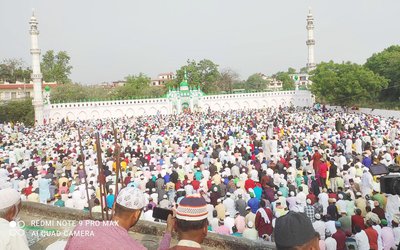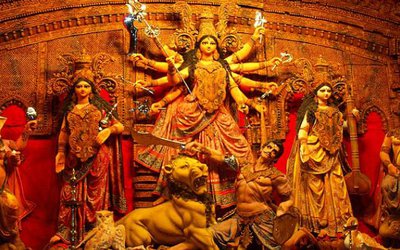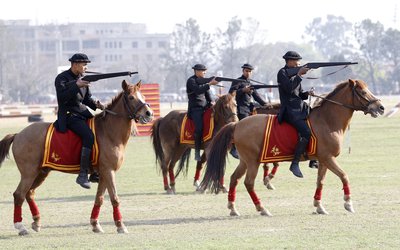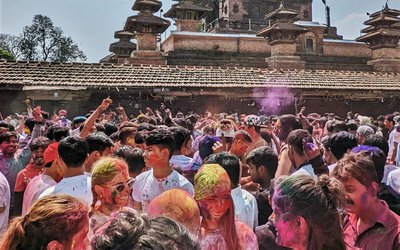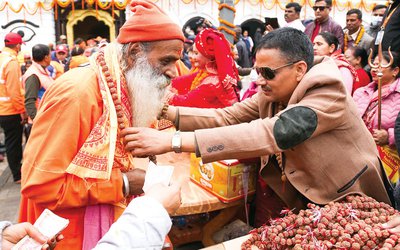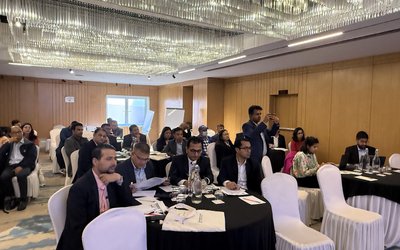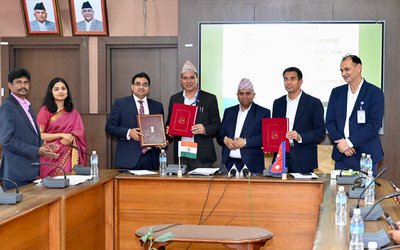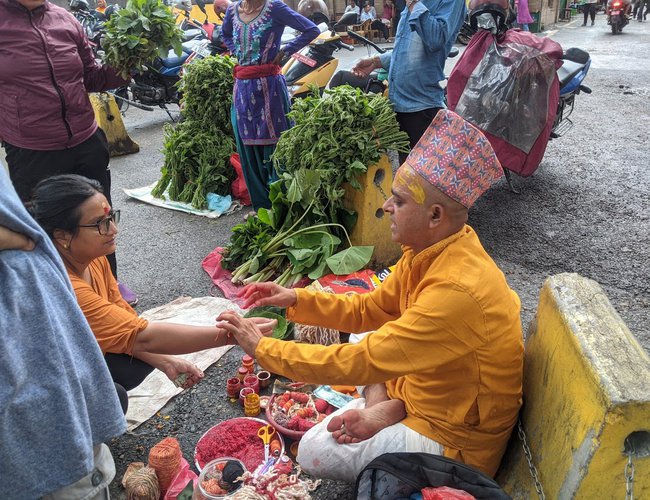
Janai Purnima is being celebrated on Monday, the full moon day, by paying homage to Lord Shiva, changing the janai (sacred thread), tying the yellow-red threads on wrists and eating Kwati, a soup prepared from nine different species of beans.
Janai Purnima is one of the major festivals celebrated by the Hindus.
In a single day, several functions are organised. First, they wear the sacred thread after taking a bath in the early morning. The second function is that sisters offer Rakshya Bandhan, fastening the sacred thread around the right wrist of their brothers as an amulet and eat Kwati. The red-yellow thread is purified through the chanting of mantras by priests as a symbol of protection from disease.
The men from Bramhin, Kshetriya and Vaishya varna (hierarchical group) change the janai on the day after shaving their head and taking bath.
Normally, this sacred thread is worn diagonally from the left shoulder to the right waist, crossing the chest and they chant the Gayatri Mantra.
Janai Purnima, a Hindu Festival, is observed on the full moon day in Shravan month. A person wearing the Janai thread should have control over body, speech and mind. This year Nepalese will celebrate the festival on August 19.
This day is also celebrated as Rakchya Bandhan and Kwati Puni. In various places of Nepal, people celebrate it visiting the ponds and rivers taking dip. On the day before Janai Purnima, male members of the Brahmin and Chettri community cut their hair and do a clean shaving. A partial fast is observed on the day – non-vegetarian food is avoided and also food made from onion and garlic.
The Janai Purnima is performed by a priest. Verses from the holy book are chanted and the new thread is sanctified. At the end of the ceremony, the thread is placed worn by all male members.
On the same day, Rakshabandhan is observed in Nepal. In Nepal, Rakshabandhan Rakhi is tied by all people and is tied for good luck.
This year Raksha Bandhan is on August 19. It is celebrated on the full moon day of Shukla Paksha of Shravan month which is also known as Shravan Poornima or Kjari Poonam.
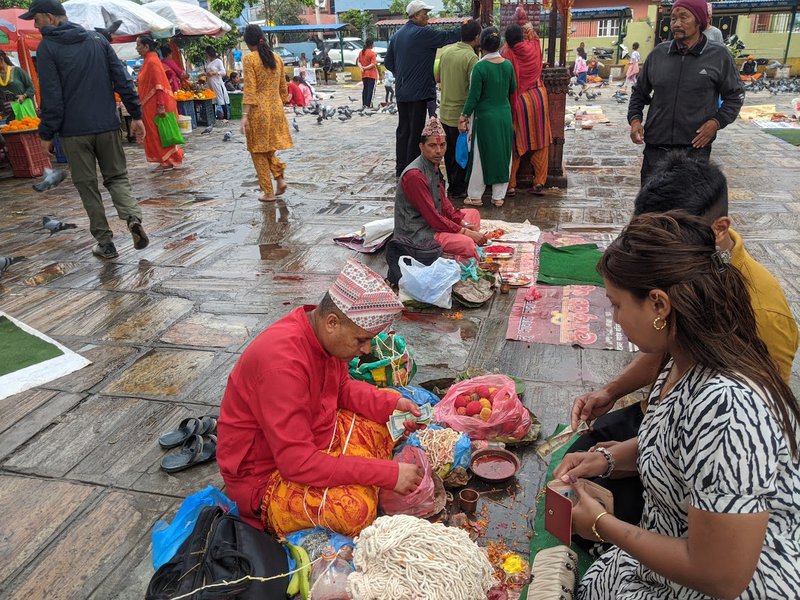
Janai Purnima is the sacred thread-changing ceremony observed in Nepal. Janai Purnima 2024 date is August 19. Male members of the Nepali Brahmin community and the Chettri community change the sacred thread worn by them known as Janai. The changing of the thread takes place after a long ceremony involving the chanting of mantras.
Rakchya Bandhan
Raksha Bandhan has its roots in a popular incident described in the epic, Mahabharata. Once Lord Krishna was flying a kite and cut one of his fingers with the thread. Then Draupadi tore a piece from her saree and tied it on Krishna's finger to stop the bleeding. Moved by the gesture, Krishna promised her that he will protect her from all evils throughout his life.
These days, when sisters tie rakhi, brothers offer them gifts and sweets. Sweet dishes are cooked at home and all family members wear new clothes.
Tying the Rakhi, giving gifts, and performing aarti, are just a few of the lovely customs that accompany Raksha Bandhan. This is the time of year when families get closer and connections are stronger. The best thing about Hindu festivals is that they unite the entire family under one roof.
The festival is often observed between cousins and other distant relatives in addition to the family. The festival unites people from different ethnic and religious backgrounds, overcomes the boundaries of biological family, and stresses love and harmony via ritual. That is what makes Raksha Bandhan so beautiful.
The special occasion of Raksha Bandhan is here. It's an opportunity to embrace sibling love and cherish the bond. India as a whole celebrates it with great enthusiasm. Raksha Bandhan is made more enjoyable by lovely rakhis, homemade sweets, presents, and puja. Any Hindu festival is incomplete without religious rituals. In Raksha Bandhan prayers are offered to god and then sisters worship their brothers and tie rakhis on their wrists while chanting the Raksha Mantra. It brings positivity and eliminate all the negative energies from his life.
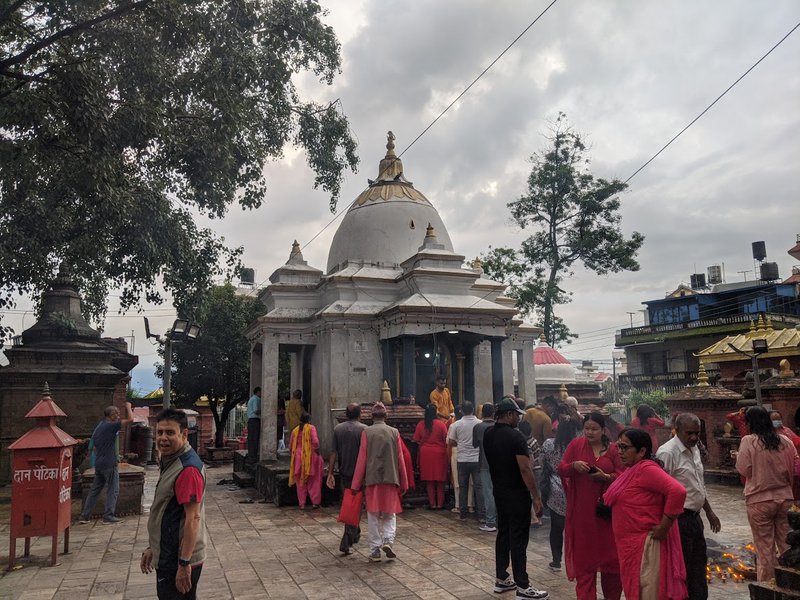
According to Hindu tradition, Brahmins and Kshatriya men have been wearing Yajnopavit, i.e. Janai. After chanting the Gayatri mantra in the ears of the boy (Batuk) by the Guru-Purohit after performing the ritual vratbandha karma, it is accepted that the Guru Purohit has prepared the mantra by placing it under the right hand on the left shoulder with a firm resolve to follow the path of.
How is Kwati Punhi celebrated?
The Newar community celebrates the same day as Kwati Punhi or Gunhi Punhi or Kwati Khane Din. They tie a ‘dora’ on their wrist on this day as they do not wear Janai on their body.
They take a bath early in the morning and visit a nearby temple, where they will find a priest who ties dora. A dora is a thread just like Janai but worn on the wrist.
The next day of Janai Purnima is followed by Gai Jatra. On this day, the dora tied on the wrist is now tied on the tail of a cow. It is believed that the cow will guide the soul to heaven afterlife.
After tying the dora, Newar celebrates Gunhi Punhi or Kwati Punhi by preparing a special dish at their home. The special dish is called ‘Kwati’.
Kwati is said to bring strength and warmth to our bodies. The Kwati is prepared only on this very day, so the name Kwati Punhi occurred.
Kwati is a thick soup made up of a combination of several beans and sprouts. The variety of beans and sprouts ranges from 9 to 12 types.
The beans and sprouts are soaked in water a day earlier so that it becomes soft. Then, the next day, it is put in the pressure cooker with various spices and lots of water. After a few whistles, the Kwati is ready to be served.
Janai Purnima is a Hindu festival that is celebrated in Nepal. It is also known as the sacred thread festival. On this day, Hindus take a sacred bath in the river/home and change their Janai, which is a thread that is worn around the wrist.
Janai Purnima is observed in the month of Shrawan. It is called Rakshya Bandhan as this festival observes the bond of purity and security. This festival is celebrated by Hindus all over the world.
Janai Purnima is Sacred Thread Festival. On this day, Hindu men, especially the Brahmins and Chettris perform their annual change of Janai and all who celebrates this festival put a scared thread around their wrist.
What is Janai
Janai is a cotton string worn across the chest by Hindu male. This thread is only given to males during a long and impressive religious ceremony called Bratabandhan. Almost all the religion has type of Bratabandhan, but known by different names. Bratabandhan is basically a formal process of accepting someone in the religion.
The Janai initiates the boy into manhood and commands them to devotedly follow the religion and the path of truth. The Janai must be worn every day of their lives after they listen their mantra from the guru during the Bartabandha.
Janai is regarded as symbol of body, speech and mind, and when the knots are tied the person wearing it is supposed to gain complete control over each of them.
This cord is changed if it becomes untidy or dishonored due to those acts which are forbidden by religion. However, Janai must be changed without fail on Rakhsya Bandhan Day.
Meaning of Janai Purnima
Janai is sacred thread, and Purnima is full moon day, thus it is Janai festival in the full moon day of Shrawan month of Bikram Sambat calendar.
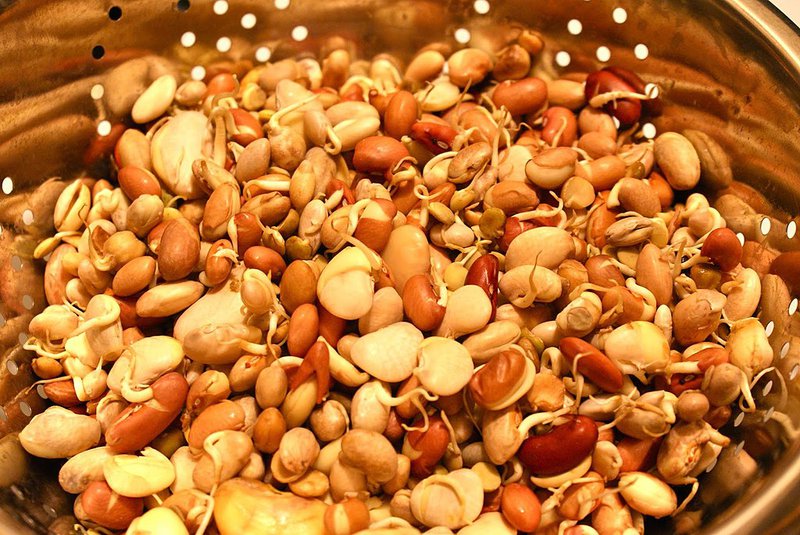
When is Janai Purnima
Janai Purnima is on Shrawan Purnima. This year Janai Purnima is on 19 August 2024, that coincides.
What do we do in Janai Purnima
A day before Janai purnima the persons wearing janai should make themselves 'clean' by shaving or cutting hair and take a good bath. They undergo a partial fasting, taking only one meal of foods considered to be 'clean' - no meat, no onions or garlic. Before big event Hindus prefer to clean their body by keeping fasting. Satvic food is prescribed for all Hindu ritual and festival.
In the Purnima morning men usually go to rivers and ponds nearby, to take secret bath dipping himself thrice in the water. Men, then change their Janai. Break the old ones.
However in cities, the family priest (Pandit / Puret) comes to the residence. The entire family gathers around pandit as he reads the importance and stories of the from a holy book (patro) and performs a ceremony, which purifies the new thread, and places it about the men’s neck across the chest. In a payment the priest is given foodstuffs and monies. The money is called Dakshina and other stuff are called Daan in Sanskrit.
What is Rakshya Bandhan Doro
Rakshya means "to protect" and bandhan is "tie" or "bond". Rakshya Bandhan is a bond or tie of protection. This thread is which is tied around the hand is called Doro. Some people even say Janai for Doro.
In Raksha Bandhan day male, female, children and kids regardless of status and caste get tied a doro (sacred colorful thread) around their wrist. Generally males get tied the thread around their right and the women around their left wrist.
They believe doro brings them good luck, when one believes, that always becomes true. People keep the doro tied in wrist till on Laxmi Puja day in Deepawali. This thread is then taken out from wrist and tied on the tail of a cow in the cow worship day (Laxmi puja) in about October.
Hindu believe that they have to cross a river Baitarni after death to reach heaven. The cow will help him/her to cross the river Baitarni, by allowing the dead to cling to her tail, if he/she ties the doro to the tail of a cow on Laxmi Puja day.
What do we do in Rakshya Bandhan
In Raksha Bandhan Bandhan morning people crowd around the Pandit who ties the orange, yellow or red thread around devotees’ wrist chanting a quick prayer/raksha bandhan mantra which goes, '
Rakshya Bandhan Mantra
"Yena baddho Balee raajaa daanavendro mahaabalah
tena twaamavi badhnaami rakshe maa chala maa chala"
"एन बद्धु बलि राजा दानबिन्द्रो महावल
तेन त्वं बध नामी रक्षे मा चल मा चल"
Meaning:
“I tie on you (the devotee) the raksha which was tied on Bali, the King of demons.
Therefore Oh Raksha! Do not ever fail to protect this devotee, do not ever fail.”
(Bhavishyottara Puran : 137/20)
Rakhi Day
This festival is also marked by the tying of a rakhi,or holy thread, by the sister on the wrist of her brother. The market is full of different colors rakhis. This festival is equivalent to Bhai Tika in Tihar to some communities across Nepal. The brother in return offers a gift to his sister and swears to look after her as she presents sweets to her brother. Rakhi provided they commit to a lifelong obligation to provide protection to the woman or girl.
Janai purnima as Kwati purnima or Gunhi Punhi
In Nepal special menu for Gunhi Punhi (Janai Purnima in Newari) is Kwati. This day is also called Kwati Punhi, where Kwati is a soup of different beans and Punhi means the full moon day. Newar people also put the sacred threads around the wrists which are to be taken off on the day of Laxmi Puja, another festival in Tihar.
In Janai Purnima Newar farmers offer different food items to frogs. Believing that worshiping the frog, who is considered an agent of the God of rainfall, by making offerings of different food items help to increase the production of crops.
Stories On Janaipurnima and Raxchhya Bandhan
Historical occurrences and mentions: In Hindu Mythology there are many stories about the Rakshya Bandhan, some of them are as follows.
Krishna and Draupadi
Another incident is from the epic Mahabharat and concerns Krishna and Draupadi, the wife of the Pandavas. She had once torn a strip of silk off her sari and tied it around Krishna's wrist to stop the bleeding from a battlefield wound. Krishna was touched by her action and declared her to be his sister, even though they were unrelated. He promised to repay the debt and then spent the next 25 years doing just that. Draupadi, inspite of being married to 5 great warriors and being a daughter of a powerful monarch, trusted and depended wholly on Krishna. Krishna repaid the debt of love during the "Cheer-Haran" (literally "clothing-robbing") of Draupadi, which occurred in the assembly of King Dhritarastra when Pandavas lost her to the Kauravas in gambling. At that time, Krishna indefinitely extended her saree through divine intervention, so it could not be removed, to save her honor. This is how he honored his rakhi-vow towards Draupadi.
King Bali and Goddess Laxmi
According to a legend the Demon King Bali was a great devotee of Lord Vishnu. Lord Vishnu had taken up the task to guard his kingdom leaving his own home in Vaikunth. Goddess Lakshmi wished to be with her lord back in her abode. She went to Bali disguised as a woman to seek refuge till her husband came back.
During the Shravan Purnima celebrations, Lakshmi tied the sacred thread to the King. Upon being asked, she revealed who she was and why she was there. The king was touched by her goodwill for his family and her purpose and requested the Lord to accompany her. He sacrificed all he had for the Lord and his devoted wife.
Thus the festival is also called Baleva that is Bali Raja's devotion to the Lord. It is said that since then it has been a tradition to invite sisters in Shravan Purnima for the thread tying ceremony or the Raksha Bandhan.
Yama and Yamuna
According to another legend, Raksha Bandhan was a ritual followed by Lord Yama (the Lord of Death) and his sister Yamuna, (the river in northern India). Yamuna tied rakhi to Yama and bestowed immortality. Yama was so moved by the serenity of the occasion that he declared that whoever gets a rakhi tied from his sister and promised her protection, will become immortal.
This day is also important for the Newars of the Kathmandu Valley. Newari celebrate it as Gunhi Punhi. Most of the Newari festivals have special foods to offer. Newari people celebrate the festivals according to the foods they produce. All the friends and families gathered around together and offer servings of the foods provided in different season in and they have different festivals for different foods they have.
- IWMMI: Water Resilience Tracker
- Apr 02, 2025
- Nepal-India Signed Memorandum of Understanding (MoU) For 10 Projects
- Apr 02, 2025
- UNRCPD To Host Confernce On Small Arms
- Apr 02, 2025
- Weather Forecast: Partly Cloudy In Kathmandu And Pokhara
- Apr 02, 2025
- Winter Session Of Parliament Ends
- Apr 01, 2025
